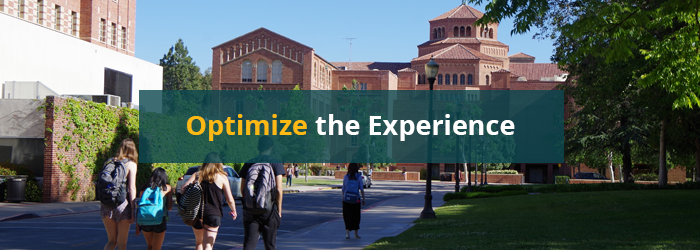
4 Ways to Optimize the University Campus Experience
Cheering on your college football team on your home turf? Fun. Waiting in line 45 minutes to enter the stadium? Not so much.
Colleges and universities increasingly compete on the basis of the student experience. How easily can students, staff, and visitors navigate the campus? Are students constantly waiting in long lines? Is your staff equipped to control the ebbs and flow of crowds across campus?
Here we highlight four key ways to optimize the university campus experience to improve campus-wide queue management, safety, and crowd control.
For all of our tips, download our Essential Guide to Optimizing the University Campus Experience.
1. Prevent long wait times from adding stress to student life.
Across campus, queuing is part of the student experience. But it doesn’t have to be a stressful or frustrating part. Nailing queue management in areas such as health centers, financial aid offices, bookstores, and stadiums can decrease wait times and the resulting stress.
When it comes to managing wait times, campuses increasingly turn to electronic queuing, automated call forward queuing, virtual queuing, and footfall analytics. Each of these solutions addresses common sources of wait time build-up with features that include reducing lag time between services, automating the process of hailing the next student in a waiting line, matching student demand to staffing, and even replacing a physical waiting line with a digital one.
2. Manage the flow of students and visitors throughout campus queues.
Lines are formed in all sorts of places around campus. The organization of these queuing areas determines how well students and visitors flow through and around the lines. To form queues that are well structured, organized, and clear, you need to cover some basics: Provide a clear and visible entrance to each queue; create an organized and structured pathway through the queue; and establish a designated point to stop and wait to be served at the end of the queue.
Rigid rail signage and retractable belt stanchions are basic yet effective solutions to keep your waiting lines running smoothly.
3. Block off or limit access to restricted areas.
Limiting unauthorized access is one of a university’s best defenses for keeping the campus safe. With physical barriers, universities can enforce which areas across campus are not permitted for the general public. Wall-mounted retractable belts and post and panel barriers can be easily deployed for a variety of crowd control and access control applications.
4. Optimize facility maintenance and address problematic conditions before they impact student satisfaction.
Students, staff, and campus visitors want – and expect – clean facilities. A lack of well-managed facilities, such as public restrooms, is found to drive down satisfaction and even deter visitors. A 2011 study from Cintas Corp. revealed that as many as 94% of U.S. adults would avoid a business with a dirty bathroom.
Short of constantly checking facilities to ensure they are in an acceptable working order, it can be hard to stay on top of facility management. Fortunately, facility maintenance solutions allow managers to receive alerts when areas are in need of attention. This can allow staff to act proactively and reactively to address issues and meet customer expectations.
Our latest guide, The Essential Guide to Optimizing the University Campus Experience, provides university managers with 8 higher education-specific solutions to improve campus-wide queue management, safety, and crowd control.
SUSCRIBIRSE
Suscríbase para mantenerse al día con los nuevos productos, información y noticias sobre los recursos.
ENTRADAS DE BLOG RECIENTES
Theft at the Register: How Strategic Queue Design Protects Profits
Leer el artículo completoRapid Deployment Crowd Control: JetTrac Portable Barriers For The Biggest Spaces
Leer el artículo completo4 Psychological Reasons Your Customers Hate Waiting In Line
Leer el artículo completoFrom Bleachers To Bookstores: 4 Campus Crowd Control Solutions
Leer el artículo completo








